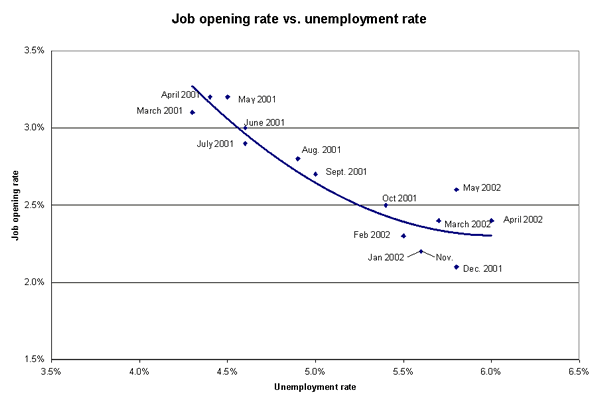A weekly presentation of downloadable charts and short analyses designed to graphically illustrate important economic issues. Updated every Wednesday.
Snapshot for August 7, 2002.
Decline in job openings fuels unemployment
A common misunderstanding about the U.S. labor market is that jobs are still readily available even in the toughest of economic times. Politicians often harangue the unemployed, waving the want ads in their faces. New data provided by the Bureau of Labor Statistics-the Job Openings and Labor Turnover Survey (JOLTS)-allows us to compare job opening rates to unemployment rates. This new measure allows us to look at both the supply-side (unemployment rates) and demand-side (job opening rate) of the labor market.
The graph below confirms that the unemployment rate increases as a result of a decline in job openings. When employers’ demand for workers falls off, the unemployment rate starts to climb. By plotting the job opening rate (the number of job openings divided by the total demand for workers) and unemployment rate for each month since the beginning of the recession, we see job openings slide as unemployment increases.

The figure above reveals three important facts. First, unemployment has increased dramatically as employers cut back on their job openings. Secondly, the job opening rate is considerably below the unemployment rate, and the differential has been growing. As of May, the number of jobs open was 3.46 million while the number of unemployed was 8.35 million, a surplus of labor of nearly 5 million would-be workers. Finally, while these data are not seasonally adjusted (making month-to-month comparisons suspect) the job opening rate has started to climb but not nearly enough to induce a reduction in unemployment. Instead many workers, with slim chances of finding a job, are choosing to leave the labor force altogether, keeping the unemployment rate artificially low.
This week’s Snapshot by EPI economist Jeffrey Wenger and research assistant Matthew Walters.
Check out the archive for past Economic Snapshots.